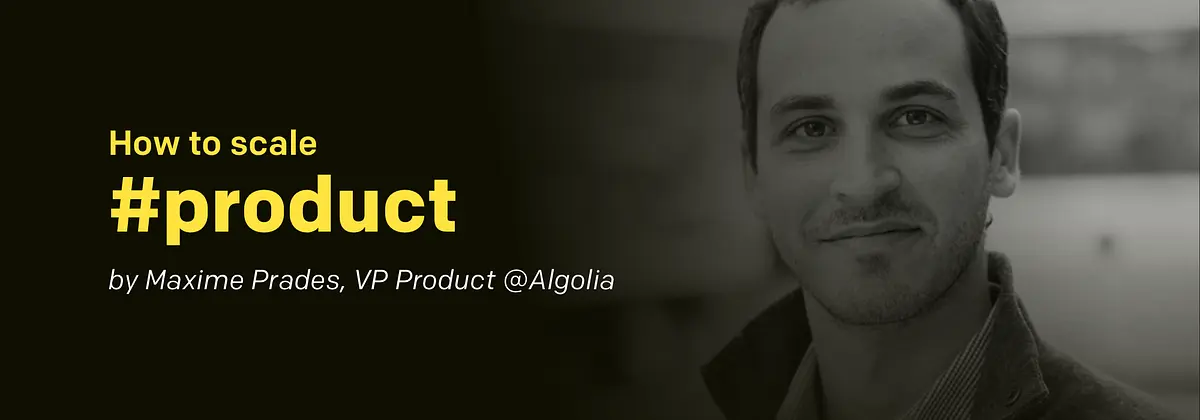This article includes key takeaways from Maxime Prades’ talk on how to scale product. You can view the full video on Youtube or check out the latest from our Scale series.
Maxime joined Zendesk in 2011. Back then their team of 200 employees worldwide included 3 PMs, they were just beginning to find their product-market fit and launching their scaling phase that would eventually bring them to a team of 2,000 including 40 PMs and an IPO in May of 2014. Looking back on his experience, Maxime delivers the best-practices and mindsets that made their growth sustainable from a product point of view.
5 key best practices
Best practice #1: Slow Down
It seems counter-intuitive, especially considering that at the start the focus is very much on “Ship or die trying”, but it’s essential to ship features in larger themes and create education in the product so as to not overwhelm your users. Doing so also helps to build coherence and predictability in terms of the evolutions within the product.
Note: testing features on samples of clients — some of which may have opted in as beta testers — is a good way to gather feedback on the features your team plans to release.
Best practice #2: Cultivate alignment
Keeping your team on the same vision is easy when you’re a small team. As soon as you grow, it’s important to make sure the same vision is shared across all your product team, and the company as a whole. It has to be rehashed in all formal communication, and can also be strengthened by daily interaction: ask the new guy how he would describe the company’s purpose. You might be surprised.
Best practice #3: Keep your roadmap open
Building the roadmap is a key exercise for product teams. And it only becomes more important as you grow. For the upcoming quarter: commit to what you will ship, how, when, and in what order of priority. For quarter +2: list areas of possible investigation and improvement of last quarter’s releases. For quarter +3: bring the discussion the level of themes, vision, problems, benefits, economic impact — never features.
Best practice #4: Build a diverse team
There is no straight path to a product career, and while there may exist certain rough categories for types of PMs, it is important to keep a balance within the team. Equally important is to build a career track early on to increase motivation and retention with opportunities for advancement within the company.
Best practice #5: Do offsites
Maxime is a strong believer in offsites. Well planned offsites are a great way for a product team to challenge each other and align one another on topics such as vision, strategy, processes, and more. Here’s what you should plan: set an objective and prepare stories, mockups, designs ahead of time. Kick things off with an exercise to get the creative juices flowing and allow some time for team-building activities. Lastly, make it your mission to deliver the objective before the end of your offsite.
4 key mindsets
Mindset #1: The cheese moves
“The cheese moves and the cheese will move again” — the words of advice are taken from Spencer Johnson’s famous book Who Moved My Cheese? and are particularly adaptable to the role of PM. As a PM its important to be comfortable with a constant change in ownership. A good practice to prevent PMs from becoming too attached to the product they are working on is to set up a rotation. An active effort PMs should make is to not just be at ease with change, but welcome it.
Mindset #2: Be a facilitator, not a creator
Decisions are easy to make as a small team. When you grow, it’s important for PMs to define the decision-making process. And to leave themselves out of it. The key mindset is to become a facilitator for new ideas, not the creator. The next game-changer idea in the company won’t come from PMs — they’ll come from someone in the company. And a marker of success in your role as PM is to allow those ideas to surface in the decision-making process by involving everyone.
Note: communicate the process clearly, leave open channels for communication (an email, a slack channel), and share ownership for the roadmap to other teams.
Mindset #3: Avoid the product trap
An all too common mistake by Product Management teams is to grow set in their ways. Whether it be in regard to the rest of the company — the so-called ivory tower syndrome — or their clients. Being excited about product, features, stories: that’s what brings people to the role of PM. But it becomes imperative for PMs to also keep their efforts in line with business objectives. Taking a step back from the product and looking at their role from a company point of view is an important step for Product Managers to grow alongside the company.
Mindset #4: No ego
At the start, being the only PM (or a product-oriented founder for that matter) is extremely gratifying: PM is a central role within the team and touches on pretty much all aspects of the company. As it grows and you become one of many PMs, its important to keep a healthy outlook: the job of PM is about thinking for the company and its bottom line, not your story and your personal ego.
Subscribe to get notified of the latest Scale talks.
References
Product Manager Zero by Ken Norton
Who Moved My Cheese? by Spencer Johnson
About Maxime Prades:
Formerly Director of Product at Zendesk, he joined the Customer Support giant when the company only had 60 employees and 3 PMs. 6 years, 13 international offices, 1,700 employees and 40 PMs later, he joined Algolia where he is currently VP of Product. Follow Maxime on Twitter.


%20(2).png)
